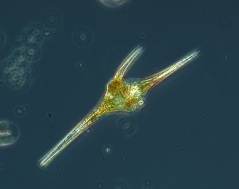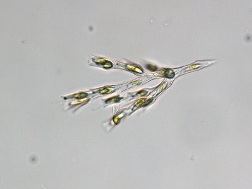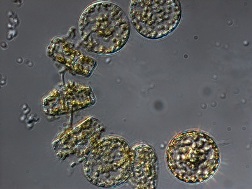GLOSSARY
Akinete: Specialized resting or dormant cell in cyanobacteria. Akinetes can survive desiccation andother adverse conditions. Usually thick-walled and larger than vegetative cells
Auxospore: Specialized cells that function to re-establish the normal size of a diatom following multiple mitotic cell divisions, which leads to a decrease in cell size. They may also be formed as a response to non-favorable conditions in which case they are referred to as “resting spores” (see resting spores)
Benthic: Living at or near the sea floor
Bioluminescent: A biochemical process where chemical energy is converted into light energy by organisms such as fireflies and deep-sea fishes. In the phytoplankton, many species of dinoflagellates are also bioluminescent
Centric: Refers to one of two orders of diatoms, characterized by their circular or discoid shape otherwise known as radial symmetry (see Pennate)
Chloroplasts: Organelles found in plant cells that conduct photosynthesis, converting light energy into chemical energy, which the plant can use for food
Cosmopolitan: Common to the whole world
Epibenthic: Living above the bottom of the sea
Epiphyte: Organism that grows on or attached to a living plant. Generally using host for physical support and not nutrition
Estuary: A semi-enclosed coastal body of water with one or more rivers or streams flowing into it, and with a free connection to the open ocean. These waters are often associated with high rates of biological productivity
Heterocyst: Also called heterocyte. Specialized cell in cyanobacteria for nitrogen fixation. Often yellowish or transparent with thick cell walls.
Littoral: Refers to the coast of an ocean or sea, or the banks of a river, lake or estuary
Mucilage: A viscous or gelatinous fluid. i.e. mucus
Neritic: This zone is considered to be the 'shallow' part of the sea, the part of the ocean extending from the low tide mark to the edge of the continental shelf
Pennate: Refers to an order of diatoms characterized by their bilaterally symmetry. Pennate diatoms can look feathered or be shaped like a wing
Resting Spore: A type of auxospore formed by diatoms during unfavorable periods, such as in winter when nutrients are low. Generally, they are very heavily silicified and allow for a period of dormancy until conditions become more favorable for growth. They are common in the life cycles of marine planktonic centric diatoms but rarely formed by pennate diatoms
Reticulation: A network of criss-crossing lines, strands, cables, or pipes. Resembling or forming a net or network; reticulate veins of a leaf
Seta: (plural - setae) A stiff hair, bristle or bristle-like structure on a living organism
Theca: Membrane system that covers the whole dinoflagellate cell consisting of three to six complex membranes
Thecal plates: Armored plates of thecate dinoflagellates, composed of microfibrils made of cellulose or polysaccharides. Size, shape, and arrangement of plates is diagnostic of species
Valve: One of two silicified halves of the cell wall of a diatom
|




